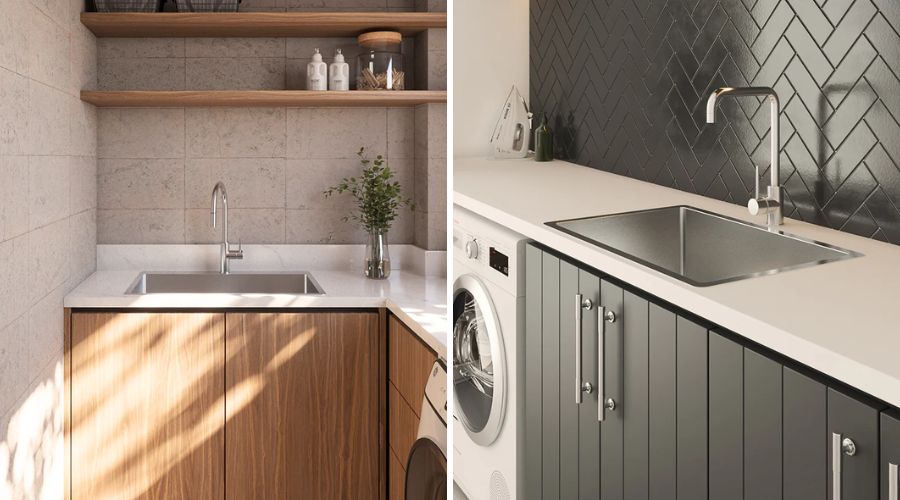Big Tiles vs Small Tiles: What Works Where?
Choosing between large and small tiles? Here’s how to decide which size suits every space in your home.

When it comes to designing a space with tiles, size really does matter. Whether you’re tiling a bathroom floor, a kitchen splashback, an outdoor patio the choice between big tiles and small tiles is about practicality, scale, and the overall vibe you want to create.
At Buildmat, we see customers weighing up these decisions every day. Should you go for sleek, expansive large-format floor tiles or lean into the charm and texture of mosaic tiles or small wall tiles? And what works best in different rooms? Here’s a guide to where big tiles and small tiles shine, and how to choose the right one for your project.
Big Tiles Make Spaces Feel Expansive
Large-format tiles (think 600 x 600 tiles and up) have become increasingly popular in Australian homes, especially in open-plan living areas, hallways, and bathrooms. Their appeal lies in their ability to make a space feel bigger and more seamless, thanks to fewer grout lines breaking up the surface.
If you’re looking for a modern, minimalist look in your living room or kitchen, big tiles are your best friend. Their clean lines and uninterrupted surfaces create a sleek canvas that pairs beautifully with stone-look tiles, porcelain tiles, and natural stone tiles.

Large tiles work beautifully in laundry rooms to create a bright, open space.
A large tile also means less grout, which isn’t just an aesthetic win but a maintenance one. Fewer grout lines equal fewer places for dirt and grime to build up, making large tiles a practical choice for high-traffic areas like entryways and kitchens.
But there’s a catch: large tiles require a very flat, even subfloor. If your floor isn’t perfectly level, installing big tiles can be tricky, and unevenness might lead to lippage. It’s worth discussing preparation with your tiler before committing.
Small Tiles Add Texture, Character & Flexibility
On the other end of the scale, small tiles – from 100 x 100 tiles to 200 x 200 tiles – bring texture, pattern, and flexibility. They’re perfect for creating intricate splashbacks, feature walls, or tiled shower niches, where you want visual interest and personality.
In small bathrooms, some people worry that small tiles might make the space feel busy. But used thoughtfully, they can add depth and dimension, especially when paired with larger format tiles elsewhere. A herringbone tile feature wall behind a vanity or a penny round tile feature in the shower elevates a simple bathroom into something special.
Small tiles also excel in spaces with curves or uneven surfaces. Need to tile a rounded bath hob or curved wall? Small tiles conform beautifully to bends and edges where large tiles wouldn’t work.

Small white kit kat tiles are the perfec option for tiling a curved wall!
For more ideas on mixing shapes and textures, take a look at our guide to finding the right tile style for your space.
Where Big Tiles Work Best
In general, large tiles work beautifully in bigger spaces, like:
- Open-plan living areas: Large tiles can visually expand the space, flowing seamlessly from kitchen to dining to lounge.
-
Bathrooms with good proportions: Big floor tiles create a spa-like feel when paired with wall tiles in the same or complementary tones.
-
Outdoor patios: A large-format porcelain tile is ideal for alfresco dining zones, blending style with slip resistance.
They’re also great if you’re tiling from floor to ceiling and want to minimise grout lines on walls, perfect for a modern bathroom or minimalist entryway.
Where Small Tiles Shine
Small tiles are the go-to for detailed work or places where curves and edges need tiling. Think:
-
Kitchen splashbacks: Small subway tiles or mosaic tiles give flexibility for layouts and let you bring in pops of colour or pattern.
-
Shower floors or niches: Mosaic tiles or smaller tiles provide better grip underfoot and work well in tight spaces.
- Feature walls: Add personality with a tiled statement wall in a powder room or living space, using smaller-format decorative tiles for texture.
Want to see more ways to mix and match? Check out our blog on how to match your wall and floor tiles in any room for helpful tips.
Mixing Tile Sizes? Yes, You Can Do Both
One of the biggest design trends right now is mixing tile sizes within the same space. For example:
- Pair a large-format floor tile with a small subway tile splashback in the kitchen.
- Use big tiles on the main bathroom floor but highlight the vanity with a mosaic tile feature wall.
- Contrast a 600x600mm porcelain floor tile with a herringbone mosaic in the shower niche.

A splashback works best with small tiles, while flooring is better with large tiles.
The key is balance: use large tiles to anchor the room and smaller tiles to highlight or accentuate specific zones. And keep colour palettes cohesive so the variation in size feels intentional, not chaotic.
Big or Small? Depends on the Space
There’s no single “right” tile size, it all comes down to the space you’re working with, the atmosphere you want to create, and how the tiles will function in daily life.
Need help choosing? Order tile samples from Buildmat to test sizes and finishes in your own lighting. And if you’re still exploring ideas, check out our blog on the most popular tiles in Australia right now for another layer of inspiration.
Explore Buildmat’s Premium Tile Collection
Whether you lean large or small, Buildmat’s curated range of different tile sizes gives you plenty of options to create a home you’ll love living in. Explore Buildmat’s full tile collection — from large format tiles to feature-ready designs like penny round tiles, feather tiles, splashback tiles, and kit kat tiles.





















































































































































































































